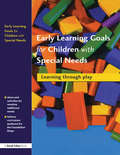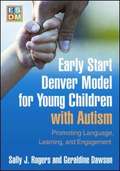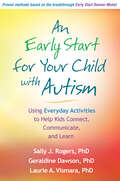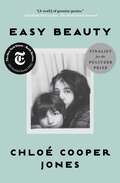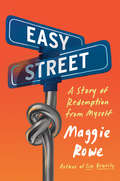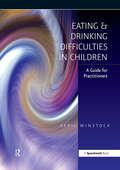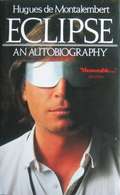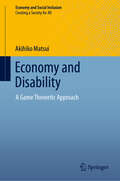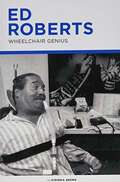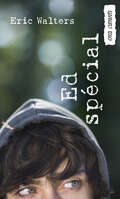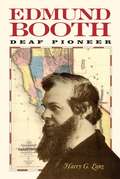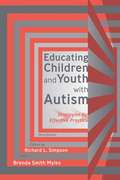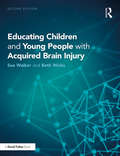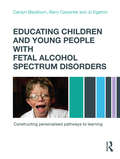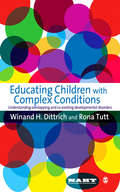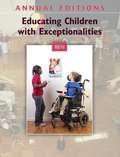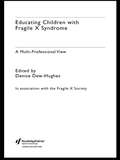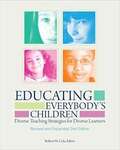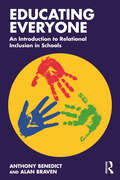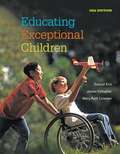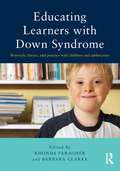- Table View
- List View
Early Learning Goals for Children with Special Needs: Learning Through Play
by Collette DrifteIn this book practitioners will find clear and workable suggestions for opening up the Early Learning Goals to children with special educational needs. It will help them to use each work area of the early years setting as a means to teach the curriculum, and offers plenty of down-to-earth advice on activities to try with children who have additional needs. Following the curriculum guidance laid down for the Foundation Stage, the author provides ideas for managing specific types of disability within the mainstream setting. Play is the focus throughout the book as the means of helping children to learn. There are photocopiable activity sheets at the end of each chapter, together with a concise list of further reading. Useful resources and contact addresses are included.
Early Learning Step by Step
by Lilli NielsenThis is Dr. Lilli Nielsen's work describing how multi handicapped children learn, and how then can be taught. This is a must for parents, teachers, and caregivers of multi handicapped blind children.
Early Start Denver Model for Young Children with Autism: Promoting Language, Learning, and Engagement
by Geraldine Dawson Sally J. RogersFrom leading authorities, this state-of-the-art manual presents the Early Start Denver Model (ESDM), the first comprehensive, empirically tested intervention specifically designed for toddlers and preschoolers with autism spectrum disorder. Supported by the principles of developmental psychology and applied behavior analysis, ESDM's intensive teaching interventions are delivered within play-based, relationship-focused routines. The manual provides structured, hands-on strategies for working with very young children in individual and group settings to promote development in such key domains as imitation; communication; social, cognitive, and motor skills; adaptive behavior; and play. Implementing individualized treatment plans for each child requires the use of an assessment tool, the Early Start Denver Model Curriculum Checklist for Young Children with Autism. A nonreproducible checklist is included in the manual for reference.
Early Start for Your Child with Autism
by Geraldine Dawson Sally J. RogersCutting-edge research reveals that parents can play a huge role in helping toddlers and preschoolers with autism spectrum disorders (ASD) connect with others and live up to their potential. This encouraging guide from the developers of a groundbreaking early intervention program provides doable, practical strategies you can use every day. Nearly all young kids-including those with ASD-have an amazing capacity to learn. Drs. Sally Rogers, Geraldine Dawson, and Laurie Vismara make it surprisingly simple to turn daily routines like breakfast or bath time into fun and rewarding learning experiences that target crucial developmental skills. Vivid examples illustrate proven techniques for promoting play, language, and engagement. Get an early start-and give your child the tools to explore and enjoy the world.
Easy Beauty: A Memoir
by Chloé Cooper JonesFrom Chloé Cooper Jones—Pulitzer Prize finalist, philosophy professor, Whiting Creative Nonfiction Grant recipient—a groundbreaking memoir about disability, motherhood, and a journey to far-flung places in search of a new way of seeing and being seen. <p><p> “I am in a bar in Brooklyn, listening to two men, my friends, discuss whether my life is worth living.” <p><p> So begins Chloé Cooper Jones’s bold, revealing account of moving through the world in a body that looks different than most. Jones learned early on to factor “pain calculations” into every plan, every situation. <p><p> Born with a rare congenital condition called sacral agenesis which affects both her stature and gait, her pain is physical. But there is also the pain of being judged and pitied for her appearance, of being dismissed as “less than.” The way she has been seen—or not seen—has informed her lens on the world her entire life. She resisted this reality by excelling academically and retreating to “the neutral room in her mind” until it passed. But after unexpectedly becoming a mother (in violation of unspoken social taboos about the disabled body), something in her shifts, and Jones sets off on a journey across the globe, reclaiming the spaces she’d been denied, and denied herself. <p><p> From the bars and domestic spaces of her life in Brooklyn to sculpture gardens in Rome; from film festivals in Utah to a Beyoncé concert in Milan; from a tennis tournament in California to the Killing Fields of Phnom Penh, Jones weaves memory, observation, experience, and aesthetic philosophy to probe the myths underlying our standards of beauty and desirability, and interrogates her own complicity in upholding those myths. With its emotional depth, its prodigious, spiky intelligence, its passion and humor, Easy Beauty is the rare memoir that has the power to make you see the world, and your place in it, with new eyes.
Easy Street: A Story of Redemption from Myself
by Maggie RoweA moving and offbeat story of unlikely friendship, the cost of ambition, and what happens when the things you&’ve always run away from show up on your doorstep. To most, Maggie Rowe appears to live on Easy Street. Her stylish home is in a fashionable Los Angeles neighborhood. She has a kind husband who makes her laugh. And after years of struggle, she is finally making a name for herself in Hollywood. But the agreeable, confident persona she presents to the world often feels like a deception to Maggie, who&’s long grappled with mental illness and feelings of inadequacy. Enter Joanna Hergert, a neurodiverse middle-aged woman who lives with her elderly mother. Maggie&’s husband, Jim, introduces her to the pair after meeting them at a local charbroiled chicken franchise. Over the next several years, she forms a friendship with Joanna and her mother—despite Joanna&’s robust romantic fixation on Jim. What begins as a mild curiosity soon blooms into a complicated and intimate friendship that will challenge Maggie to confront her mental health issues and the trade-offs she&’s made to live life on her own terms. Engrossing, moving, and wickedly funny, Easy Street is a midlife coming-of-age buddy comedy about embracing the strength of the families we fashion, finding peace with the choices we make, and, above all, learning to be compassionate with ourselves.
Eating and Drinking Difficulties in Children: A Guide for Practitioners
by April WinstockClearly illustrated, this is the ultimate practical handbook for all professionals working with children with eating and drinking difficulties, and an essential guide for all students studying this area of therapy. Covering the complex issues involved in the field of eating and drinking difficulties in children, this text: examines the theoretical background while maintaining a clear focus on its practical application; provides essential information on all the relevant issues; contains an invaluable range of photocopiable material for each chapter, which can be given to families and professional colleagues; provides a range of appendices with details of useful resources including a reference list and suppliers of equipment. April Winstock is a Speech & Language Therapist who is registered with the Health Professionals Council and has worked at the Bobath Centre, London, special schools and hospitals. She has been running courses on eating & drinking difficulties in children for many years. April currently has her own practice in which she sees children with a range of communication and eating problems.
Eavesdropping: A Life by Ear
by Stephen KuusistoBlind people are not casual listeners. From his early childhood on, Stephen Kuusisto recounts with a poet's sense of detail the surprise that comes when we are actively listening to our surroundings. There is an art to eavesdropping. Kuusisto highlights the periods of childhood when a writer first becomes aware of his curiosity and imagination: as a boy he listened to Caruso records in his grandmother's attic and spent hours in the New Hampshire woods learning the calls of birds. And as a grown man he visits cities around the world in order to discover the art of sightseeing by ear. Kuusisto writes, "In reality I cannot see the world by ear, I can only reinvent it for my own purposes." And this is his remarkable tactic for both amusement and survival, allowing him to imagine, for example, the streets of New York "crowded with Russian ghosts and wheels that have broken loose from their carriages." In Eavesdropping the reader is invited into Kuusisto's world-American poetry, music, travel, and the art of eavesdropping-to share with him all there is to hear and even "see" in his unique celebration of a hearing life.
Eclipse: A Nightmare
by Hugues De MontalembertEclipse is the autobiographical work by a young artist living in New York. It describes, from the evening he was attacked and lost his sight, the two years it took to him to go back to Life and swim freely in the sea of Java. 'I had to give birth to myself.' The beautiful, unpredictable and eccentric ballerina, Valouchka, leads him into the reconquest of the dance with life. Hospital, Rehabilitation Centre, joy, despair, love. and one morning, he closes the door behind and flies alone to Indonesia. 'Fear is the true Blindness'. You experiment in those pages a deep meditation on life, love, perception, visual world and inner vision. Poignant, poetic and sometimes hilarious, this book is a Song to Life, which questions all of us.
Eclipse: An Autobiography
by Hugues De Montalembert David NoakesUp until 1978, the author, a French count by birth, was a painter. He travelled extensively working on documentary films such as I A Dancer about Rudolph Nureyev and Margot Fonteyn. He took a deep interest in the culture of the countries he visited: the harlem voodoo in West Africa and Indonesian music in Bali. On May 25th 1978, when returning to his apartment in New York from a Greenwich Village coffee-house, he was met by two intruders who threw caustic solution in his face. At the age of thirty-five he was blinded for life. Hugues de Montalembert is currently based in Rome although he continues to travel between Europe, America and South East Asia. The French edition of ECLIPSE became a bestseller when it was published in 1982 and the author is currently working on his second book.
Eco Soma: Pain and Joy in Speculative Performance Encounters (Art After Nature)
by Petra KuppersModeling a disability culture perspective on performance practice toward socially just futures In Eco Soma, Petra Kuppers asks readers to be alert to their own embodied responses to art practice and to pay attention to themselves as active participants in a shared sociocultural world. Reading contemporary performance encounters and artful engagements, this book models a disability culture sensitivity to living in a shared world, oriented toward more socially just futures.Eco soma methods mix and merge realities on the edges of lived experience and site-specific performance. Kuppers invites us to become moths, sprout gills, listen to our heart&’s drum, and take starships into crip time. And fantasy is central to these engagements: feeling/sensing monsters, catastrophes, golden lines, heartbeats, injured sharks, dotted salamanders, kissing mammoths, and more. Kuppers illuminates ecopoetic disability culture perspectives, contending that disabled people and their co-conspirators make art to live in a changing world, in contact with feminist, queer, trans, racialized, and Indigenous art projects. By offering new ways to think, frame, and feel &“environments,&” Kuppers focuses on art-based methods of envisioning change and argues that disability can offer imaginative ways toward living well and with agency in change, unrest, and challenge.Traditional somatics teach us how to fine-tune our introspective senses and to open up the world of our own bodies, while eco soma methods extend that attention toward the creative possibilities of the reach between self, others, and the land. Eco Soma proposes an art/life method of sensory tuning to the inside and the outside simultaneously, a method that allows for a wider opening toward ethical cohabitation with human and more-than-human others.
Economy and Disability: A Game Theoretic Approach (Economy and Social Inclusion)
by Akihiko MatsuiSociety has developed so that it accommodates the needs of intertwined people, but a question arises as to which people have been accommodated. Has everyone been taken care of in an equal manner? If not, who has fallen into the gap between the institutions that are supposed to accommodate them? This book is a study of these issues of economy and disability using game theory, which has provided a means of analyzing various social phenomena. Part I provides actual cases related to economy and disability, with the stories based on interviews by the author. Part II is geared toward a game theoretic analysis. This book explains disability-related issues by game theory and innovates that theory by deeply contemplating the issues.It is not common that first-rate theorists manage to make their research relevant and applicable to the most pressing problems our society faces these days. This is the remarkable achievement of this book. Akihiko Matsui, an internationally recognized leader in economic theory, succeeds in bringing profound game theoretical insights to the questions of disability, the social norms relating to it, and the ethical and economic problems they raise. The book is a tour de force, brilliantly combining economic and sociology, mathematics and philosophy, to provide us a fresh look at the way we run modern societies.Itzahk Gilboa, Professor, Eitan Berglas School of Economics, Tel-Aviv University and Professor of Economics and Decision Sciences, HEC, ParisThe present world faces a broad range of societal problems such as discrimination against minorities and conflicts between groups. The market mechanism may solve some of these dilemmas, but many others remain. This book targets various societal problems and provides game theoretical approaches to them, stressing the importance of social institutions including the market system and individual interactive attitudes to society. Aki Matsui’s splendid Economy and Disability is indispensable for students and scholars interested in social science, particularly in economic theory, and gives a better understanding of these phenomena and their potential cures.Mamoru Kaneko, Professor, Faculty of Political Science and Economics, Waseda UniversityIn this book, Aki Matsui is revealed to be a fully-fledged humanist in the guise of a game theoretician. He beautifully presents game-theoretical ideas while at the same time suggesting how society should relate to the disabled. This unique combination makes Economy and Disability—apart from anything else—a truly moving book.Ariel Rubinstein, Professor of Economics, Eitan Berglas School of Economics, Tel-Aviv University and Professor of Economics, New York University
Ed Roberts: Wheelchair Genius
by Steven E. BrownMiddle grade biography of late 20th century American disability rights pioneer and activist, Ed Roberts.
Ed Special: (Special Edward) (French Currents)
by Eric WaltersEdward is a classic slacker. He's got better ways to spend his time than toiling over homework, and as long as he gets passing grades he's happy. When his fifty percent average is threatened he has to find a way to pull up his grades without applying himself. Edward discovers that special education students get more time to complete tests, and he thinks he's found the perfect scam. Little does he know that manipulating everyone around him will take more work than he ever imagined.
Edmund Booth: Deaf Pioneer
by Harry G. LangEdmund Booth was born in 1810 and died in 1905, and during the 94 years of his life, he epitomized virtually everything that characterized an American legend of that century. In his prime, Booth stood 6 feet, 3 inches tall, weighed in at 210 pounds, and wore a long, full beard. He taught school in Hartford, CT, then followed his wife-to-be Mary Ann Walworth west to Anamosa, Iowa, where in 1840, he built the area's first frame house. He pulled up stakes nine years later to travel the Overland Trail on his way to join the California Gold Rush. After he returned to Iowa in 1854, he became the editor of the Anamosa Eureka, the local newspaper. Edmund Booth fit perfectly the mold of the ingenious pioneer of 19th-century America, except for one unusual difference -- he was deaf. Edmund Booth: Deaf Pioneer follows the amazing career of this American original and his equally amazing wife in fascinating detail. Author Harry G. Lang vividly portrays Booth and his wife by drawing from a remarkable array of original material. A prolific writer, Booth corresponded with his fiancé from the American School for the Deaf in Hartford, and he kept a journal during his days on the California trail, parts of which have been reproduced here. He also wrote an autobiographical essay when he was 75, and his many newspaper articles through the years bore first-hand witness to the history of his times, from the Civil War to the advent of the 20th century. Edmund Booth depicts a larger-than-life man in larger-than-life times, but perhaps its greatest contribution derives from its narrative about pioneer days as seen through Deaf eyes. Booth became a respected senior statesman of the American Deaf community, and blended with his stories of the era's events are anecdotes and issues vital to Deaf people and their families. His story proves again that extraordinary people vary in many ways, but they often possess a common motive in acting to enhance their own communities.
Educating Children And Youth With Autism: Strategies For Effective Practice
by Brenda Smith Myles Richard L. SimpsonChildren and youth with autism spectrum disorders (ASD) have highly distinctive and idiosyncratic needs and characteristics. ASD is an especially challenging and perplexing disability. The need for knowledgeable and skilled educational professionals was the primary motivation for preparing this third edition of Educating Children and Youth With Autism: Strategies for Effective Practice. This edition includes chapters written by internationally recognized authorities on ASD.
Educating Children and Young People with Acquired Brain Injury
by Sue Walker Beth WicksEducating Children with Acquired Brain Injury is an authoritative resource book on the effects of brain injury on young people and how educators can understand and support their needs. This new edition has been updated to reflect changes to legislation and practice relating to special educational needs and will enable you to maximise the learning opportunities for young people with acquired brain injury (ABI). Considering key areas in special educational needs such as communication, interaction, cognition, sensory and physical needs, the book provides information on the multifaceted needs of children and young people with ABI and how these needs can be met. This book will help you to: Understand the difficulties that young people with ABI experience Support these students by using appropriate strategies to help their learning Understand and address the social and emotional difficulties experienced by these students Work in partnership with families and other professionals Understand information from other professionals by reference to a glossary of terms Access further useful information from relevant resources and organisations Written for SENCOs, teachers, teaching assistants, educational psychologists and other education professionals across all settings, Educating Children with Acquired Brain Injury is full of useful information and advice for parents and other family members, clinical and behavioural psychologists, therapists and support workers involved with children and young people with ABI.
Educating Children and Young People with Fetal Alcohol Spectrum Disorders: Constructing Personalised Pathways to Learning
by Barry Carpenter Jo Egerton Carolyn BlackburnThe range of learning difficulties associated with children who have fetal alcohol spectrum disorders (FASDs) has been highlighted as an emerging but little understood area of Special Educational Needs. This engaging, timely, and highly practical book will raise awareness about FASDs and their associated difficulties across the entire education workforce. It provides a range of specialist, practical tried-and-tested teaching and learning strategies, from which teachers and support staff may construct personalised learning plans for students with FASDs, and will help improve outcomes for all their children. It also: explains the impact that FASDs can have on the child’s brain; discusses the overlapping and co-existing disorders, such as ADHD and autism spectrum disorders; shows how to support and empower teachers; provides ready-to-use teaching resources and strategies that can be used directly in the classroom. Informed by the very latest research and written by leading experts in the field, Educating Children and Young People with Fetal Alcohol Spectrum Disorders will prove invaluable for experienced teachers and teaching assistants who are engaging in Continuing Professional Development, as well as newly qualified and training Initial Teacher Training students.
Educating Children with Complex Conditions: Understanding Overlapping & Co-existing Developmental Disorders
by Dr Rona Tutt Dr Winand H Dittrich'This is an important contribution to the field of SEN. By putting the child into a context, the authors recognize that each child is unique and cannot be reduced to a simple diagnosis. Highly recommended' - SEN Magazine 'In just over 100 pages this book gives the clearest account I have yet read of 'overlapping and co-existing conditions'....All professionals working with children with complex conditions will find it both interesting and practical' - Special 'The book is written in an easily digestible form, and provides insight into overlapping conditions as well as advice on support to those working to meeting the needs of pupils with these complex disorders' - SNIP 'Many have tried but few have succeeded in bringing together the varying threads of special educational needs into a concise and proactive format. I know, having tried and failed myself. Here at last Dittrich and Tutt have created a fascinating account of the current SEN world and have succeeded, in my opinion, in demystifying and explaining the significance of specific SEN terms, while illustrating that overlap is more the norm than the exception. Well researched and written with both clarity and experience, the authors stress that there really is no such thing as a SEN child, but that some children are in essence more interesting in their learning and behaviour style than others.' Fintan O'Regan, Author and Consultant There are growing numbers of children displaying the symptoms of more than one condition or disorder, and this has led to those involved in education needing to understand which conditions commonly overlap or co-exist, and how to meet children's more complex needs. By bringing together some of the latest research on how the brain learns with what is known about identifying developmental disorders that appear to have a common biological basis, this book covers: - what is known about a common group of disorders, (including ADHD, autistic spectrum disorders, dyslexia, dyscalculia and dyspraxia) - how to recognise when a child may have more than one condition - what teaching approaches and strategies might be most relevant Written in a non-technical style, the book blends together scientific knowledge from different disciplines and translates it into practical terms for school leaders, practitioners in the field of special educational needs and disabilities, and students following courses in higher education.
Educating Children with Exceptionalities 10/11 (20th edition)
by Karen L. FreibergThe Annual Editions series provides students with convenient, inexpensive access to current, carefully selected articles from the public press. Annual Editions: Educating Children with Exceptionalities 10/11 is an easy-to-use reader that presents articles on important topics such as fitting in, severe disabilities, gifted and talented, and many more.
Educating Children with Fragile X Syndrome: A Multi-Professional View
by Denise Dew-HughesWhat is Fragile X? The most common inherited cause of learning difficulties, affecting a child's ability to tackle key areas such as literacy and numeracy, and causing behaviour problems and social anxiety. What can teachers do to help children with Fragile X become more effective learners? This definitive text will provide essential support and information for teachers with the expertise of an international field of researchers, whose variety of perspectives contribute to a unique, multi-professional approach. Each chapter of the book suggests practical intervention strategies, based on sound educational principles expressed in clear non-specific terms. A range of important topics are considered, including: * the physical and behavioural characteristics of Fragile X* the effects of Fragile X on learning* medication and therapy* related conditions such as autism and attention deficit disorders. Breaking down the barriers of professional practice, this book establishes the groundwork for successful and valuable multi-professional teamwork. By providing immediate access to a body of empirical knowledge and advice from other disciplines, it will encourage teachers to incorporate this approach into their own practice. Everyone responsible for the education of a child with Fragile X syndrome should read this book.
Educating Everybody's Children: Diverse Teaching Strategies for Diverse Learners
by Robert W. ColeDesigned to promote reflection, discussion, and action among the entire learning community, Educating Everybody's Children encapsulates what research has revealed about successfully addressing the needs of students from economically, ethnically, culturally, and linguistically diverse groups and identifies a wide range of effective principles and instructional strategies. <p><p> Although good teaching works well with all students, educators must develop an extensive repertoire of instructional tools to meet the varying needs of students from diverse backgrounds. Those tools and the knowledge base behind them are the foundation of this expanded and revised second edition of Educating Everybody's Children. Each strategy discussed in the book includes classroom examples and a list of the research studies that support it. <p><p> The most important thing we have learned as a result of the education reform movement is that student achievement stands or falls on the motivation and skills of teachers. We must ensure that all teachers are capable of delivering a standards‑based curriculum that describes what students should know and be able to do, and that these standards are delivered by means of a rich and engaging "pedagogy of plenty." By these two acts we can ensure that all schools will be ready and able to educate everybody's children.
Educating Everyone: An Introduction to Relational Inclusion in Schools
by Anthony Benedict Alan BravenDrawing on the latest neuroscientific research and rooted in good practice, Educating Everyone presents the concept of Relational Inclusion, encouraging schools to reconsider their traditional perspectives on mental health and behaviour.The authors pose thought-provoking questions about longstanding conventional approaches to behaviour management in schools that have remained largely unchanged since the inception of compulsory state education. They present a range of strategies that extend beyond the needs of individuals with complex requirements who are often isolated as a result of the misguided concept that they can be "taught" to conform. Relational Inclusion is advocated as an inclusive approach that can benefit all children and adults, fostering comprehension of the underlying causes behind behavioural challenges. This book provides an essential framework for responding to students' behaviour that has been tried and tested in real classrooms. Schools play a pivotal role in teaching these essential skills and attitudes, and this accessible resource provides educators with valuable insights and practical strategies for creating a nurturing and supportive environment within school settings. It will appeal to educationalists across the educational sector, including headteachers and policy leaders as well as behaviour leads, classroom teachers, support staff, and anyone who works with children and young people.
Educating Exceptional Children
by Mary Ruth Coleman Samuel Kirk James J. GallagherAuthored by luminaries in the special education field, EDUCATING EXCEPTIONAL CHILDREN introduces readers to each of the thirteen disability categories, and to the needs of children who are gifted and talented. The fourteenth edition continues to focus on the strengths of previous editions, while also providing new material about such important hot topics as genetics, neurology, inclusion, assistive technology, and information processing. The book provides key, research-based teaching methods and strategies for children with various exceptionalities, and also offers analysis of ecological factors that influence the exceptional child in and out of the classroom. This edition also features a new chapter on children with ADD/ADHD, new diagnosis information from the DSM-5, coverage of CEC and Common Core State Standards, the most current teaching techniques for each category, and current coverage of the Response to Intervention Model.
Educating Learners with Down Syndrome: Research, theory, and practice with children and adolescents
by Barbara Clarke Rhonda FaragherFor individuals with Down syndrome, the extent of the effect of intellectual disability depends largely on the degree of provision of appropriate support and intervention. In Educating Learners with Down Syndrome, editors Rhonda Faragher and Barbara Clarke have brought together a number of expert contributors, whose chapters review recent findings in the field of DS education, highlight promising practices, and identify areas for future research. While the emphasis is primarily on the school years, links to early intervention and to life post-16 are made, with chapters organized into three parts: conceptual overview of issues in learning and teaching, learning mathematics, and literacy development. The book is also united by the cohesive themes of assessment, evidence-based practice, and inclusive practices. Educating Learners with Down Syndrome importantly incorporates the voices of individuals with Down syndrome, whose personal narratives add significance to the research mission of the text and demonstrate the authors' inclusive philosophy. Aimed at researchers, teacher educators, higher degree students, and policy makers, this book is the first of its kind to provide a compendium of research on educating learners with Down syndrome.
